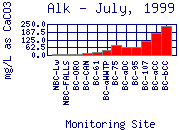 |
|
 |
|
ALKALINITY
Alkalinity levels in upper Boulder Creek are very low, ranging from 0 to
60 mg/L at mountain and canyon sampling sites. In general, the alkalinity of
Boulder Creek increases as it moves downstream (for example, see July 1999).
 After passing through the City of Boulder, alkalinity values in Boulder Creek are between 20 and 120 mg/L.
Downstream of the Boulder Wastewater Treatment Plant (WWTP), alkalinity values are between 30 and 250 mg/L.
This increase is mostly due to changes in geology.
After passing through the City of Boulder, alkalinity values in Boulder Creek are between 20 and 120 mg/L.
Downstream of the Boulder Wastewater Treatment Plant (WWTP), alkalinity values are between 30 and 250 mg/L.
This increase is mostly due to changes in geology.
![]() In the mountains, Boulder Creek passes over granitic and metamorphic rocks, which provide little to no buffering capacity to the water.
As Boulder Creek moves into the plains, the geology changes to sedimentary rocks, including sandstones and calcareous (calcite-containing) shales.
The calcite (CaCO3) dissolves in the water, releasing bicarbonate (HCO3-), and carbonate (CO32-).
Runoff from human activities also contributes to alkalinity.
In the mountains, Boulder Creek passes over granitic and metamorphic rocks, which provide little to no buffering capacity to the water.
As Boulder Creek moves into the plains, the geology changes to sedimentary rocks, including sandstones and calcareous (calcite-containing) shales.
The calcite (CaCO3) dissolves in the water, releasing bicarbonate (HCO3-), and carbonate (CO32-).
Runoff from human activities also contributes to alkalinity.
 Flow rate largely influences alkalinity in Boulder Creek.
>From April to September, flow in Boulder Creek is higher due to snowmelt runoff and thunderstorms.
The high volume of water dilutes alkalinity in the creek. Therefore, alkalinity is often much higher in low-flow months (typically October-March) than in high-flow months (typically April-September) For example, see BC-61 in 1999.
Flow rate largely influences alkalinity in Boulder Creek.
>From April to September, flow in Boulder Creek is higher due to snowmelt runoff and thunderstorms.
The high volume of water dilutes alkalinity in the creek. Therefore, alkalinity is often much higher in low-flow months (typically October-March) than in high-flow months (typically April-September) For example, see BC-61 in 1999.
During some months, there is a significant spike in alkalinity concentration in Boulder Creek at the site BC-75 (for example, see January 1998).
 This increase is due to the effluent from the WWTP.
The contribution of the WWTP effluent is more obvious in low-flow months, because wastewater effluent dominates flow in lower Boulder Creek at these times.
This increase is due to the effluent from the WWTP.
The contribution of the WWTP effluent is more obvious in low-flow months, because wastewater effluent dominates flow in lower Boulder Creek at these times.
During some months, there is a spike in alkalinity concentration at the sampling site below the confluence of Boulder Creek and Coal Creek. This may be due to some activity near the sampling point, such as water diversion and return, soil erosion, or construction, or from effluent from other WWTPs that discharge into Coal Creek (Superior, Lafayette, Louisville, and Erie).
Because alkalinity levels in Boulder Creek are relatively low, pH is not very well buffered and can be easily altered by other factors. See the section on pH for more information on how pH varies in Boulder Creek.

COMPARISON TO REGULATIONS
There arenít general water quality standards for alkalinity. Levels of 20-200 mg/L are typical of fresh water, and levels of 100-200 mg/L will stabilize the pH level in a stream. Samples collected from North Boulder Creek/Boulder Creek in the mountains have alkalinity values between 0 and 60 mg/L. After passing through the City of Boulder, alkalinity values in Boulder Creek are between 20 and 120 mg/L. Downstream of the Boulder WWTP, alkalinity values are between 30 and 250 mg/L.